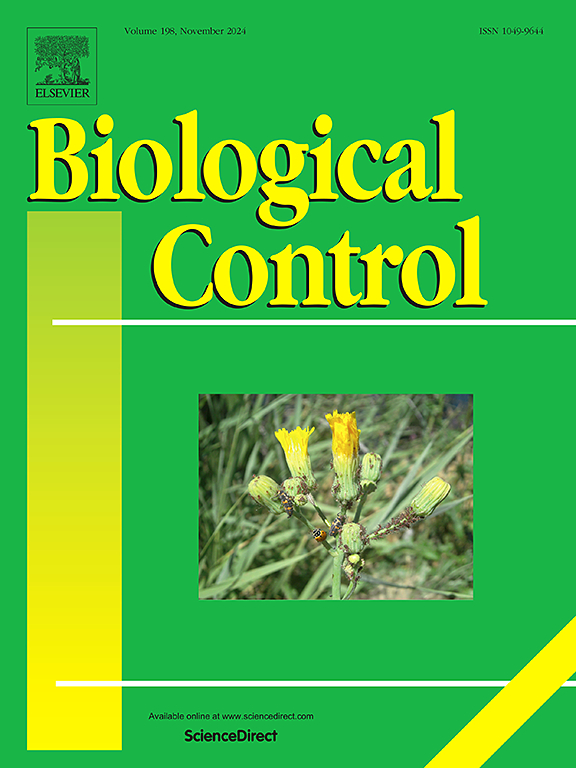The effect of soil on the efficacy of a nematode-based biopesticide of slugs
IF 3.7
2区 农林科学
Q2 BIOTECHNOLOGY & APPLIED MICROBIOLOGY
引用次数: 0
Abstract
Several slug species are serious pests of agriculture and are difficult to control. One popular control method is the nematode Phasmarhabditis hermaphrodita, which has been used in slug control for > 25 years. However, there are reports of it failing to reduce slug numbers and damage in the field for unknown reasons. This may be due to lack of knowledge about how P. hermaphrodita performs when applied to different soils. We therefore assessed the survival, movement and pathogenicity of P. hermaphrodita infective juveniles (IJs) when added to six different soils (compost with and without peat, clay loam, loam, sandy loam and sandy soil). The soils were either frozen or autoclaved before use to eradicate resident nematodes prior to the experiment. P. hermaphrodita survived best in autoclaved compost without peat and in experiments with frozen soils, compost with and without peat was best. Survival of P. hermaphrodita was similar in other soils. Interestingly, in peat-free compost P. hermaphrodita reproduced prolifically, which may affect the long-term success of the nematode in the field as other life stages, apart from the IJ stage, cannot infect slugs. In infection experiments we found P. hermaphrodita added to compost with peat killed slugs faster than nematodes added to a sandy clay loam or sandy soil. In movement experiments, the nematodes remained within 3 cm of the application point in each soil. In summary, soil type severely affects P. hermaphrodita survival, and the ability to kill slugs; therefore it should be assessed by farmers and gardeners before use.

土壤对基于线虫的蛞蝓生物杀虫剂药效的影响
几种蛞蝓是严重的农业害虫,防治难度大。一种流行的控制方法是雌雄同体Phasmarhabditis hermaphrodita线虫,它已被用于控制鼻涕虫。25年。然而,有报道称,由于未知的原因,它未能减少井段塞的数量和损坏。这可能是由于缺乏关于雌雄同体在不同土壤中的表现的知识。因此,我们评估了两性假单胞虫(P. hermaphrodita)感染幼虫(IJs)在6种不同土壤(含和不含泥炭、粘壤土、壤土、砂壤土和沙土的堆肥)中的生存、移动和致病性。在实验之前,土壤要么被冷冻,要么被高压灭菌,以根除常驻线虫。在不加泥炭的蒸压堆肥中雌雄同体的成活率最好,在冻土中,加和不加泥炭的堆肥中成活率最好。雌雄同体在其他土壤中的存活率相似。有趣的是,在不含泥炭的堆肥中,雌雄同体线虫繁殖大量,这可能会影响线虫在田间的长期成功,因为除了IJ期外,其他生命阶段不能感染鼻涕虫。在感染实验中,我们发现将雌雄同体线虫添加到含有泥炭的堆肥中比将线虫添加到沙质粘土壤土或沙质土壤中更快地杀死蛞蝓。在运动实验中,线虫在每个土壤中保持在施用点3cm以内。综上所述,土壤类型严重影响雌雄同体的生存和对蛞蝓的杀伤能力;因此,在使用前应由农民和园丁进行评估。
本文章由计算机程序翻译,如有差异,请以英文原文为准。
求助全文
约1分钟内获得全文
求助全文
来源期刊

Biological Control
生物-昆虫学
CiteScore
7.40
自引率
7.10%
发文量
220
审稿时长
63 days
期刊介绍:
Biological control is an environmentally sound and effective means of reducing or mitigating pests and pest effects through the use of natural enemies. The aim of Biological Control is to promote this science and technology through publication of original research articles and reviews of research and theory. The journal devotes a section to reports on biotechnologies dealing with the elucidation and use of genes or gene products for the enhancement of biological control agents.
The journal encompasses biological control of viral, microbial, nematode, insect, mite, weed, and vertebrate pests in agriculture, aquatic, forest, natural resource, stored product, and urban environments. Biological control of arthropod pests of human and domestic animals is also included. Ecological, molecular, and biotechnological approaches to the understanding of biological control are welcome.
 求助内容:
求助内容: 应助结果提醒方式:
应助结果提醒方式:


